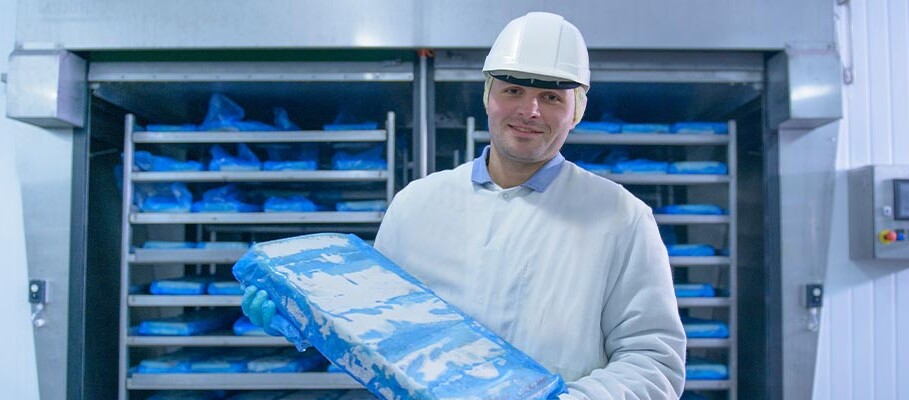Table of Content
- The Growing Popularity of Frozen Meals Across Europe
- The Ten Frozen Food Trends 2025 Every Supplier of Frozen Food Should Follow
- What’s Inside Matters: Ingredient Trends for Frozen Meals in 2025
- Sustainability and Food Packaging in Frozen Food: Meeting Consumer and Regulatory Demands
- How the Supplier of Frozen Food Can Adapt to Evolving Generational Tastes
- Conclusion
1. The Growing Popularity of Frozen Meals Across Europe
With the EU frozen food market projected to surpass €80 billion by 2025, the supplier of frozen food is stepping up innovation in everything from food packaging to product variety—offering frozen cake, frozen edamame and halal frozen food to meet shifting tastes and cultural preferences.
Frozen food is no longer just a fallback for busy weeknights—it’s becoming a central part of how Europeans shop, cook, and eat. Considering the rising food prices, especially for fresh produce, frozen meals have become a budget-friendly and convenient option for busy lifestyles.
According to Eurostat, food inflation across the EU remained around 2.7% in early 2025, prompting many consumers to rethink how they manage their grocery budgets.
Suppliers of frozen food are meeting this moment with products that not only reduce food waste but also offer longer shelf life without sacrificing quality.
Demographic changes are accelerating the shift. Smaller households, aging populations, and dual-income families are all looking for easy-to-prepare yet high-quality meals. This is fueling demand for solutions like vegan frozen food, and halal frozen food—diverse offerings that reflect both convenience and individual preferences.
Improved freezing technology and advances in food packaging have helped to change the view about frozen products from second-best options into premium choices. Today’s consumers are reaching for frozen fruit for smoothies, frozen cake for gatherings, and superfood breakfast items that combine health with speed.
In Germany and the Nordics, where sustainability and food efficiency are high on the agenda, frozen food has gained significant ground. The French market, traditionally centered on fresh produce, has also seen a notable uptick in frozen purchases, particularly among younger urban consumers.
With an annual growth rate of 6.2% according to Mordor Intelligence, the European frozen food market is growing steadily, making it clear that frozen food is no longer just convenient. It’s essential, adaptable, and increasingly aspirational for households across Europe.
2. The Ten Frozen Food Trends 2025 Every Supplier of Frozen Food Should Follow
Frozen food is becoming a regular part of everyday life in Europe. As a result, different tastes, new technologies, and current eating habits are changing how these products are made, sold, and used in the future.
Below, we explore ten key trends every supplier of frozen food should watch—each offering insight into how to align with shifting demand and seize new growth across Europe.
Health-Focused Frozen Food
Health-focused frozen products are on the rise across Europe, as consumers seek out convenient options that support wellness goals such as muscle recovery, digestive health, and allergen management.
Demand is increasing for high-protein meals, probiotic-rich ingredients, and fortified products with added nutrients like fiber and Omega-3. The growing popularity of GLP-1 weight-loss medications is also shaping interest in portion-controlled, calorie-conscious meals.
To stay competitive in this growing segment, the supplier of frozen food can focus on clean-label, functional ingredients and support private label development for wellness-oriented product lines.
Better Home Cooking
As consumers spend more time eating at home, the demand for restaurant-quality frozen food has risen sharply. Products like Italian-style risottos, French-inspired sauces, and premium seafood entrees are reforming the frozen aisle.
This growing demand for quality is reflected in the rise of sous vide frozen dishes, authentic ethnic selections, and collaborations with well-known chefs. Regional tastes are also shaping innovation: plant-based lasagna is especially popular in Scandinavia, while gourmet frozen seafood is gaining ground in France.
Suppliers of frozen food can tap into this trend by focusing on high-quality ingredients, highlighting regional authenticity, and offering innovative formats that bring restaurant-style meals into homes.
Globally Inspired Frozen Cuisine
Europeans are more adventurous than ever in their food choices. From Asian stir-fry kits to Middle Eastern mezze and Latin American empanadas, global flavours are in high demand.
Cultural fusion, immigration, and increased travel have all contributed to this trend, with authenticity remaining a top priority. Consumers value traditional preparation methods, regional ingredients, and transparent sourcing.
The supplier of frozen food can support this trend by providing authentic spices, sauces, and ready-to-use global components to manufacturers and retailers developing culturally rich frozen product lines.
Snacks, Bowls and Easy Meals
Frozen food is getting smaller—and smarter. Tapas-style bites, falafel snacks, and single-serve gratins are seeing strong demand, particularly in northern and western Europe.
This trend is driven by changing household structures. Young professionals, busy parents, and single-person households are looking for flexible, portioned products that suit varied occasions—from lunchboxes to late-night snacks.
To respond to this shift, the supplier of frozen food may explore innovations in small formats and invest in food packaging solutions that cater to varied, on-the-go consumption habits.

Strong Flavors and Spices
European consumers—especially Gen Z and Millennials—are seeking excitement in the frozen aisle. Spicy curries, chili-infused pasta, and North African harissa-based dishes are on the rise.
Urban and multicultural regions are fueling this demand, as shoppers increasingly seek out new flavors that combine authenticity with bold, sensory appeal.
Suppliers of frozen food have the chance to play a key role in this trend by offering heat-infused ingredients such as gochujang, chili oil, and chipotle—helping brands introduce more adventurous and globally inspired flavor profiles to frozen meals.
Halal and Specialty Labels
Halal-certified meats, snacks, and desserts are now common in both ethnic retailers and mainstream supermarket shelves.
Countries like France, Germany, and the UK have seen strong growth in halal-certified stock keeping units—both branded and private label. Other certifications such as kosher, vegan, and allergen-free are also gaining traction.
Meeting this demand offers a valuable opportunity for the supplier of frozen food to work with certified producers, build transparent supply chains, and explore export growth in halal and specialty nutrition markets.
AI-Driven Customization and Forecasting
Artificial intelligence is reshaping the research and development of frozen meals. Brands are using AI tools to predict flavor trends, customize recipes for niche audiences, and optimize freezing techniques for texture and taste.
From dynamic inventory management to predictive analytics, AI is also helping suppliers and retailers respond faster to market shifts.
Suppliers of frozen food can stay ahead in product innovation and market responsiveness by forming tech partnerships and using data-driven tools.
Frozen Breakfast and Anytime Meals
Frozen food is no longer just for dinner. High-protein waffles, smoothie kits, and egg-based breakfast cups are driving growth in the frozen breakfast segment—especially in the UK, Nordics, and urban areas of Germany.
This "anytime eating" trend is driven by convenience-focused consumers who want nutritious, ready-to-go options that work for mornings, midday snacks, or even late-night meals.
A supplier of frozen food can meet this demand by creating versatile frozen SKUs designed for non-traditional mealtimes and convenient, on-the-go consumption.
Hybrid Diets
Plant-based isn’t going away—it’s evolving. Many European consumers are blending animal and plant proteins to meet both health and sustainability goals.
Meat-veg combos, plant-forward frozen entrees, and sustainable protein swaps are becoming the norm, especially among younger and middle-aged shoppers.
Blending nutritional value, taste, and sustainability, the supplier of frozen food can lead in this space by developing hybrid products and flexitarian-friendly formats that appeal to modern dietary preferences.
Regional Provenance and Localism
Local flavor is in. Consumers increasingly value regional identity in frozen products—whether it’s Tuscan soups, Alpine-inspired ready meals, or Nordic-style seafood.
This trend is being reinforced by EU origin labelling regulations and growing consumer interest in storytelling and traceability.
To make the most of this trend, a supplier of frozen food should emphasize regional origin, collaborate with local producers, and weave local identity into both packaging and storytelling.
3. What’s Inside Matters: Ingredient Trends for Frozen Meals in 2025
Ingredient innovation is at the heart of the frozen food sector’s momentum in 2025. As consumer expectations around health, transparency, and variety continue to grow, so does the demand for specific components that meet those needs across frozen meals, snacks, and desserts.
For every supplier of frozen food, understanding which ingredients are gaining ground is essential to staying relevant and competitive.
- Plant-Based Proteins: Vegan frozen food continues to surge, with soy, lentils, jackfruit, and emerging proteins like fava beans and lupin gaining ground in frozen pizza, bowls, and ready meals.
- Ancient Grains and Legumes: Ingredients such as quinoa, barley, and buckwheat are increasingly featured in Nordic and German frozen product lines, including superfood breakfast items and fiber-rich frozen meals.
- Fermented and Gut-Friendly Additions: Kimchi, miso, fermented vegetables, and kefir bases are being integrated into frozen bowls and international recipes, adding probiotic value and boosting gut health appeal.
- Superfoods and Adaptogens: Functional ingredients like turmeric, spirulina, and reishi are making their way into smoothie-ready frozen fruit blends, fortified frozen desserts, and wellness-focused meals.
- Low-Calorie, Low-Carb Bases: Cauliflower rice, konjac noodles, and protein-enhanced bases are becoming staples in portion-controlled frozen meals, especially those targeting consumers using GLP-1 medications.
And as clean label expectations take center stage, more buyers are looking for frozen foods that are simply made, with easy-to-recognize ingredients and no artificial additives. This is leading B2B buyers to find a trusted supplier of frozen food that offers clean-label products and sources responsibly.

4. Sustainability and Food Packaging in Frozen Food: Meeting Consumer and Regulatory Demands
Sustainability is now a basic requirement for frozen food in Europe. From recyclable packaging to lower-emission production, sustainability is influencing how frozen food is made and packaged.
Both retailers and consumers are paying more attention to the environmental impact of products. For the supplier of frozen food, this means rethinking food packaging choices and production processes to meet the growing demand for efficiency and responsibility.
Key packaging trends include mono-material packaging, reduced plastic use, and clear recyclability labels, which are especially important for products like frozen fruit, frozen cake, and vegan or halal frozen food. These categories often require packaging that maintains freshness while meeting sustainability expectations.
European regulations, like the Packaging and Packaging Waste Regulation (PPWR), are pushing companies to use materials that reduce waste, improve recyclability, and lower carbon emissions. These changes are also calling on companies to reformulate products to stay compliant while maintaining appeal.
For the supplier of frozen food, using recyclable or mono-material packaging, adopting clean production methods, and ensuring traceable supply chains will be essential to meet the expectations of both consumers and retailers.
5. How the Supplier of Frozen Food Can Adapt to Evolving Generational Tastes
Consumer preferences are increasingly being shaped by generational values, and every supplier of frozen food must adapt to these shifting demands to stay relevant and expand their reach in Europe.
Millennials and Gen Z are leading the charge with their focus on health, originality, and ethical sourcing. These groups are highly engaged with products that offer both functionality and excitement, increasing the demand for bold flavors, plant-based formats, and functional snacks.
Vegan frozen food, superfoods and products with added health benefits are gaining popularity among these younger consumers. They are also more likely to choose products that align with their ethical values, such as halal frozen food or those using sustainable food packaging.
On the other hand, Gen X and Baby Boomers tend to prioritize practicality and health concerns that come with aging. These generations look for heart-friendly meals, low-sodium options, and portion-controlled frozen meals that are easy to prepare without sacrificing nutrition.
Since this group prioritizes health maintenance and managing chronic conditions, products like frozen edamame and low-fat frozen meals have become key offerings for the supplier of frozen food.
Understanding the unique needs and values of each consumer group is crucial. Suppliers of frozen food should support brands in developing demographic-specific frozen products that cater to health, convenience, and ethical considerations, ensuring broad appeal across generations.

6. Conclusion
The frozen food sector in Europe is growing steadily as inflation, changing family dynamics, and post-COVID habits reshape how people shop and eat.
Consumers are turning to frozen meals not just for convenience, but for healthier, more affordable options that fit their busy lives.
To stay competitive, the supplier of frozen food needs to keep up with trends like wellness-focused products, global flavors, and sustainable food packaging. The key is to offer variety and quality that appeal to both younger and older generations.
As the market evolves, another opportunity worth exploring is the role of frozen food in supporting healthier public diets on a larger scale.
With many European governments prioritizing nutrition and reducing lifestyle-related diseases, frozen food—often overlooked in policy conversations—could become a key ally.
Fortified frozen meals, portion-controlled options, and easy access to vegetables year-round can all support national health strategies, especially in underserved areas where fresh produce is harder to access.
For the supplier of frozen food, this creates potential for partnerships with public institutions, schools, and healthcare providers—broadening the impact and relevance of frozen food beyond retail shelves.
For more information on trends and market shifts in the food industry, read these insightful articles on europages Inside Business blog:
French Cheese Crisis: Impact on Manufacturers of Cheese
Edible Food Packaging: A Sustainable Future?
Fermented Foods: Benefits, Trends & Sustainability

